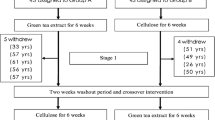Abstract
Objective
To evaluate the effect of the consumption of green tea on components of MS in the elderly.
Design
Intervention study.
Setting
The sample was selected from the Geriatric Service of Hospital São Lucas of Pontifical Catholic University of Rio Grande do Sul.
Participants
45 elderly with MS were enrolled and allocated into two groups: green tea group (GTG, n = 24), who drank green tea and control group (CG, n= 21) without intervention.
Intervention
The GTG received sachets of 1.0 g of green tea, and should drink three cups per day for 60 days and the CG was instructed not to make changes in their lifestyle.
Measurements
The diagnostic criteria for MS used were the International Diabetes Federation. The lipidic and glycemie profile, and anthropometric measurements were evaluated before and after intervention.
Results
There was a statistically significant weight loss only in GTG [71.5±12.6 kg to 70.3±12.6 kg (p<0.001)]. A statistically significant decrease in BMI [−0.5±0.4 kg/m2 in GTG and −0.2±0.6 kg/m2 in CG (P=0.032)] and waist circumference [−2.2±2.0 cm in GTG and − 0.3±1.8 cm in CG (P=0.002)] were observed. The intake of green tea did not change the biochemical parameters.
Conclusion
The consumption of green tea was effective in inducing weight loss, reducing BMI and waist circumference in the elderly with MS.
Similar content being viewed by others
References
Thielecke F, Boschmann M (2009) The potential role of green tea catechins in the prevention of the metabolic syndrome — A review. Phytochemistry 70:11–24.
Cabrera C, Artacho R, Gimenez R (2006) Beneficial effects of green tea — a review. J Am Coll Nutr 25:79–99.
Basu A, Lucas EA (2007) Mechanisms and effects of green tea on cardiovascular health. Nutr Rev 65(8):361–375.
Nakachi K, Eguchi H, Imai K (2003) Can teatime increase one’s lifetime? Ageing Res Rev 2:1–10.275
Grundy SM, Cleeman JI, Daniels SR, Donato KA, Eckel RH, Franklin BA, Gordon DJ, Krauss RM, Savage PJ, Smith SC Jr, Spertus JA, Costa F (2005) Diagnosis and management of the metabolic syndrome. An American Heart Association/National Heart Lung, and Blood Institute/Scientific Statement. Circulation 112:2735–2752.
Alberti KG, Zimmet P, Shaw J (2006) Metabolic syndrome — a new world-wide definition. A Consensus Statement from the International Diabetes Federation. Diabet Med 23(5): 469–480.
Sichieri R, Everhart JE (1998) Validity of a Brazilian food frequency questionary against dietary recalls and estimated energy intake. Nutr Res 18(10): 1649–1659. 286
Lipschitz DA (1994) Screening for nutritional status in the elderly. Prim Care 21(l):55–67.
Friedewald WT, Levi RI, Fredrickson DS (1972) Estimation of the concentration of low density lipoproteins cholesterol in plasma without use of the ultracentrifuge. Clin Chem 18:499–291 502.
Ikeda I (2008) Multifunctional effects of green tea catechins on prevention of the metabolic syndrome. AsiaPac J din Nutr 1:273–274.
Kovacs EMR, Lejeune MPGM, Nijs I, Westwrterp-Plantenga MS (2004) Effects of green tea on weight maintenance after body-weight loss. Br J Nutr 91(3):431–437.
Wu CH, Lu FH, Chang CS, Chang TC, Wang RH, Chang CJ (2003) Relationship among habitual tea consumption, percent body fat, and body fat distribution. Obes Res 11(9): 1088–1095
Després JP, Lemieux I (2006) Abdominal obesity and metabolic syndrome. Nature 444:881–887.
Marin P, Andersson B, Ottosson M, Olbe L, Chowdhury B, Kvist H, Holm G, Sjôstrom L, Bjômtorp P (1992) The morphology and metabolism of intraabdominal adipose tissue in men. Metabolism 41(11): 1242–1248.
Chen D, Wang CY, Lambert JD, Ai N, Welsh WJ, Yang CS (2005) Inhibition of human liver catechol-O-methyl transferase by tea catechins and their metabolites: structure-activity relationship and molecular-modeling studies. Biochem Pharmacol 69(10):1523–1531.
Tsuchida T, Itakura H, Nakamura H (2002) Reduction of body fat in humans by long-term ingestion of catechins. Prog Med 9:2189–2203.
Nagao T, Hase T, Tokimitsu I (2007) A green tea extract high in catechins reduces body fat and cardiovascular risks in humans. Obesity 15(6): 1473–1483.
Lin J, Delia-Fera MA, Baile CA (2005) Green tea polyphenol epigallocatequin gallate inhibits adipogenesis and induces apoptosis in 3T3-L1 adipocytes. Obes Res 13(6):982–990.
Dullo AG, Seydoux L, Girardier L, Chantre P, Valdermander J (2000) Green tea and thermogenesis interactions between catechin-polyphenols, caffeine and sympathetic activity, hit 325 J Obes 24:252–58.
Kao YH, Hiipakka RA, Liao S (2000) Modulation of endocrine systems and food intake by green tea epigaUocatecbin gallate. Endocrinology 1419(3):980–987.
Santana MB, Mandarino MG, Cardoso JR, Dichi I, Dichi JB, Camargo AEI, Fabris BA, Rodrigues RJ, Fatel EC, Nixdorf SL, Simão AN, Cecchini R, Barbosa DS (2008) Association between soy and green tea (Camellia sinensis) diminishes hypercholesterolemia and increases total plasma antioxidant potential in dyslipidemic subjects. Nutrition 24: 562–568.
Lin J, Delia-Fera MA, Baile CA (2005) Green tea polyphenol epigallocatequin gallate inhibits adipogenesis and induces apoptosis in 3T3-L1 adipocytes. Obes Res 13(6):982–990. 337 338
Yang CS, Landau JM (2000) Effects of tea consumption on nutrition and health. J Nutr 130:2409–2412.
Author information
Authors and Affiliations
Corresponding author
Rights and permissions
About this article
Cite this article
Vieira Senger, A.E., Schwanke, C.H.A., Gomes, I. et al. Effect of green tea (Camellia sinensis) consumption on the components of metabolic syndrome in elderly. J Nutr Health Aging 16, 738–742 (2012). https://doi.org/10.1007/s12603-012-0081-5
Received:
Accepted:
Published:
Issue Date:
DOI: https://doi.org/10.1007/s12603-012-0081-5




